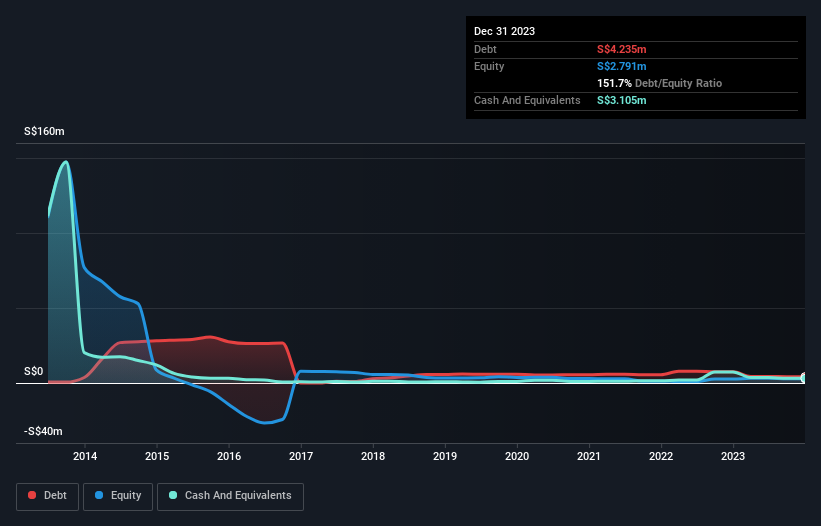- Singapore
- /
- Commercial Services
- /
- SGX:A33
We Think Southern Archipelago (SGX:A33) Is Taking Some Risk With Its Debt
Some say volatility, rather than debt, is the best way to think about risk as an investor, but Warren Buffett famously said that 'Volatility is far from synonymous with risk.' When we think about how risky a company is, we always like to look at its use of debt, since debt overload can lead to ruin. As with many other companies Southern Archipelago Ltd. (SGX:A33) makes use of debt. But is this debt a concern to shareholders?
When Is Debt A Problem?
Debt assists a business until the business has trouble paying it off, either with new capital or with free cash flow. If things get really bad, the lenders can take control of the business. While that is not too common, we often do see indebted companies permanently diluting shareholders because lenders force them to raise capital at a distressed price. Of course, debt can be an important tool in businesses, particularly capital heavy businesses. The first thing to do when considering how much debt a business uses is to look at its cash and debt together.
View our latest analysis for Southern Archipelago
How Much Debt Does Southern Archipelago Carry?
The image below, which you can click on for greater detail, shows that Southern Archipelago had debt of S$4.23m at the end of December 2023, a reduction from S$7.45m over a year. On the flip side, it has S$3.11m in cash leading to net debt of about S$1.13m.

How Healthy Is Southern Archipelago's Balance Sheet?
Zooming in on the latest balance sheet data, we can see that Southern Archipelago had liabilities of S$4.15m due within 12 months and liabilities of S$1.95m due beyond that. Offsetting these obligations, it had cash of S$3.11m as well as receivables valued at S$437.0k due within 12 months. So its liabilities total S$2.55m more than the combination of its cash and short-term receivables.
Of course, Southern Archipelago has a market capitalization of S$55.1m, so these liabilities are probably manageable. But there are sufficient liabilities that we would certainly recommend shareholders continue to monitor the balance sheet, going forward.
In order to size up a company's debt relative to its earnings, we calculate its net debt divided by its earnings before interest, tax, depreciation, and amortization (EBITDA) and its earnings before interest and tax (EBIT) divided by its interest expense (its interest cover). The advantage of this approach is that we take into account both the absolute quantum of debt (with net debt to EBITDA) and the actual interest expenses associated with that debt (with its interest cover ratio).
Given net debt is only 1.1 times EBITDA, it is initially surprising to see that Southern Archipelago's EBIT has low interest coverage of 1.5 times. So one way or the other, it's clear the debt levels are not trivial. Notably, Southern Archipelago made a loss at the EBIT level, last year, but improved that to positive EBIT of S$370k in the last twelve months. When analysing debt levels, the balance sheet is the obvious place to start. But you can't view debt in total isolation; since Southern Archipelago will need earnings to service that debt. So when considering debt, it's definitely worth looking at the earnings trend. Click here for an interactive snapshot.
Finally, while the tax-man may adore accounting profits, lenders only accept cold hard cash. So it is important to check how much of its earnings before interest and tax (EBIT) converts to actual free cash flow. During the last year, Southern Archipelago burned a lot of cash. While that may be a result of expenditure for growth, it does make the debt far more risky.
Our View
Both Southern Archipelago's conversion of EBIT to free cash flow and its interest cover were discouraging. But its not so bad at managing its debt, based on its EBITDA,. When we consider all the factors discussed, it seems to us that Southern Archipelago is taking some risks with its use of debt. So while that leverage does boost returns on equity, we wouldn't really want to see it increase from here. The balance sheet is clearly the area to focus on when you are analysing debt. However, not all investment risk resides within the balance sheet - far from it. For example Southern Archipelago has 4 warning signs (and 2 which are significant) we think you should know about.
Of course, if you're the type of investor who prefers buying stocks without the burden of debt, then don't hesitate to discover our exclusive list of net cash growth stocks, today.
New: Manage All Your Stock Portfolios in One Place
We've created the ultimate portfolio companion for stock investors, and it's free.
• Connect an unlimited number of Portfolios and see your total in one currency
• Be alerted to new Warning Signs or Risks via email or mobile
• Track the Fair Value of your stocks
Have feedback on this article? Concerned about the content? Get in touch with us directly. Alternatively, email editorial-team (at) simplywallst.com.
This article by Simply Wall St is general in nature. We provide commentary based on historical data and analyst forecasts only using an unbiased methodology and our articles are not intended to be financial advice. It does not constitute a recommendation to buy or sell any stock, and does not take account of your objectives, or your financial situation. We aim to bring you long-term focused analysis driven by fundamental data. Note that our analysis may not factor in the latest price-sensitive company announcements or qualitative material. Simply Wall St has no position in any stocks mentioned.
About SGX:A33
Southern Archipelago
An investment holding company, provides contract sterilisation and polymerisation services in Singapore, Malaysia, and Indonesia.
Low risk with weak fundamentals.
Market Insights
Community Narratives




